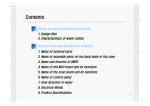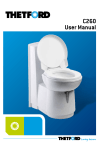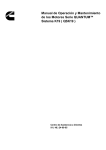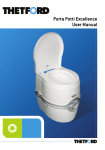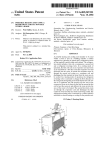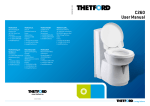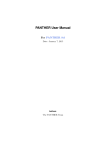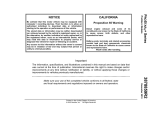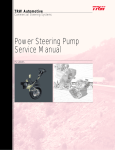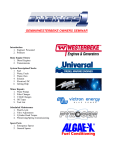Download Engine Overheating
Transcript
Tartan 37 Technical Resources This information is based on the experience of Tartan 37 owners, and is made available as a convenience to other owners. Individual boats and experiences may vary, and neither the Tartan 37 Sailing Association nor the owner(s) presenting this information assume any responsibility for conditions resulting from its use on other boats. By downloading this article, the user acknowledges that any information contained herein is used at his/her sole risk. Chapter 3: Engine, transmission and prop Section 5: Engine Overheating Contributed by John Harvey, #16 New Day Engine Overheating Mashed up by John Harvey (New Day, T-37C #16) from notes by Jim Voelxen (Odyssey, T37C #191), Gary Van Voorhis (Recess, T-37 #321), Mike Civello (High Flight, T-37C #299) and others found in the T37 Forum. There are two independent water circuits in the diesel engine; the fresh water/coolant mix circuit that picks up heat from the engine and the exterior water circuit that dumps the heat overboard. These two circuits are connected only at the heat exchanger. Either one or both can malfunction and cause overheating. To keep them distinct, we will call the fresh water/ coolant mix the 50:50 circuit and the exterior water circuit we will call the raw-water circuit (“raw” because it depends on what the boat is floating in). When troubleshooting an overheating problem, as Yogi Berra once put it, “You can observe a lot just by looking.” The exhaust water flow observations that follow may pinpoint the problem. However, there may be no one thing that fixes the problem. Past experience shows that overheating can be caused by a number of small problems, on their own not significant, but when combined cause overheating. For our elderly T-37s with original engines it will be wise to perform all these checks and repairs at least every five years. This tech note is mostly generic material but when specific to the particulars of either of the Westerbeke 40 or 50 engine is so noted. ---------------------------------------------------------------------------------------------------------** When an engine overheats, first check the raw-water overboard discharge (exhaust): If there is No Flow or only a dribble, the most likely causes of overheating are in the raw-water circuit: Ensure the raw-water intake valve is open. The raw-water intake is blocked externally. Check for a plastic bag, a clump of sea grass, or other material covering or plugging the inlet. Clean the Intake Thru-Hull. Years of bottom paint may partially block the intake strainer on the thru-hull. Remove it, scrape out any blockage and clear the slots with a screwdriver. Inspect and clear the thru-hull. The raw-water filter or strainer is clogged with sediment, sand, goo, grass, or living critters such as jellyfish and algae. Open and clean it out. If there is Diminished Flow, consider these likely causes in the raw-water circuit: Damaged or missing impeller vanes in the raw-water pump and downstream. If the impeller is completely destroyed, there will be no flow. The impeller should be replaced every year or two, as the vanes become brittle with age and may snap off, wear unevenly or take on a permanent set, degrading the impeller’s function. Immediately downstream, clean out the discharge fitting (elbow) on the raw-water pump. You can’t see anything from either end of the elbow, but take the elbow off the pump and ' rod'it with a stiff piece of wire. You may find rubber ends of a failed impeller jammed in the elbow. To backflush the raw-water circuit: 1. Disconnect the raw water pump outlet at the pump (marked S/W pump outlet in the photo). 2. Disconnect the anti-siphon inlet (the raw water connection into the exhaust elbow at the elbow); this means you' re back flushing through the oil cooler because the oil cooler inlet hose is about 2 inches and would be tough to remove. 3. Get a bucket and a hose with a jet nozzle. 4. Press the jet firmly into the anti-siphon hose and watch for impeller bits to flow out. 5. Change directions for a few seconds when you stop getting bits to shake things loose. Every now and again blow on the hose until the circuit is dry so you can gauge the resistance. 6. Repeat 4 and 5 until you get three consecutive clean buckets and you can blow freely. Rebuild the Raw-Water Pump. Replace all items that could affect the pump’s capacity: (especially) the impeller, cam, cover plate, and back wear plate. Even though the ones that are in the pump look ' OK' , it seems that replacing all those items improves seawater flow. The impeller is normally replaced at least every two years. Keep a spare in light (olive) oil. Clean the Heat Exchanger(s). The heat exchanger(s) (1. fresh or raw water and 2. oil) may be dirty or clogged up with sediment and other deposits. The fresh water/raw water heat exchanger is a large metal can with numerous small diameter tubes inside. Its function is to transfer the engine heat from the 50:50 coolant to a portion of the raw water which is then dumped overboard by rejoining the rest of the raw water through the exhaust elbow. Sometimes removing the end cap of a heat exchanger will reveal the cause of overheating. The entire raw-water cooling system should be flushed periodically to remove salt and sediment deposits. Sometimes it will be necessary to remove a clogged heat exchanger and the oil cooler so they can be “boiled out” with an acid bath at a radiator shop to purge its water channels and restore it to like-new condition. This cleans out all scale and mineral deposits. The shop will pressure-test (them) for leaks. For the W50, you need to remove the exhaust manifold to remove the water heat exchanger. It' s not hard - just awkward to do. The W40 exchanger is more in the open and held in place with two large hose clamps. Note that there is a rubber inspection cap that goes over one end of the water heat exchanger. Be sure that you get it on correctly. There is a groove in it that needs to fit over the heat exchanger' s divider plate. If it is on wrong (i.e., water is allowed to bypass the divider plate), you can seriously reduce the heat exchanger' s cooling capacity. If it isn' t re-installed correctly, allowing some sea water flow to bypass the heat exchanger, will cause these same symptoms. Finally beware, the cap can slip off when under pressure – you must have the clamp positioned inside the raised ring around the can’s opening. Open and inspect the heat exchanger annually. While the heat exchanger(s) are out, be sure to replace the zinc(s). The exhaust injection elbow is clogged with carbon deposits or other solids, reducing the flow of cooling water and exhaust gases. Routinely running the engine at high or moderate rpm under load, as opposed to long periods of idling at low speeds, will help avert this problem. Inspect the exhaust elbow for blockage. Remove the hose to the muffler and scrape out any deposits with a stiff wire, screwdriver, small chisel, what have you. You may find that your water injection elbow is a "home made" welded black iron unit corroded shut. Purchase of a new Westerbeke cast aluminum water injection elbow may be worth the cost. Preventative Maintenance of the Raw-Water Circuit. Greatly decrease the need to repair your raw-water circuit again by putting a Y valve and alternate hose on your engine salt water intake and filling the engine with freshwater from a pail when you leave. The insides of the heat exchangers will stay whistle clean for hundreds of hours. Running a few gallons of white vinegar through the rawwater circuit will help dissolve the salt--you might do this just before you change the pencil zincs on fall decommissioning. If the Flow Appears Normal, and especially if the discharge is cool to the touch, then you should suspect one of these common causes in the 50:50 coolant circuit: The thermostat is stuck closed and should be removed or replaced. (Note: Some diesel engines will operate just fine—temporarily—without a thermostat.) It’s worth remembering that diesel engines are most efficient running at high temperatures; a coolant temperature of 180oF is not uncommon. The coolant level is low. The level of the 50:50 mix of antifreeze and water should be checked routinely, and more coolant should be added as needed. Caution: Remove the cap to the expansion tank only after it has cooled to the touch. When replacing the cap, be certain it is closed snugly and seals the system. Frequent replenishment of the coolant suggests a leak and requires further investigation. The V-belt driving the water pump and alternator is broken or slipping so there is little circulation. Keep a spare belt on board. Even a new belt needs re-tensioning sometimes and should be regularly inspected for wear. Expect to find some slippage or excessive wear if you see fine dark “belt dust” settling around the engine mounts or at the engine’s base near the belt. To check belt tension, apply thumb pressure midway along the longest belt run; tension is okay if the belt deflects about 1/2 inch. Replace the expansion tank cap. There may be an improper seal at the cap. Replace this $5 cap and the proper pressure can be achieved and the engine will run cooler. This cap is pressuresensitive. The spring-loaded plate lifts when the pressure goes above a certain measure and allows coolant to go into the overflow bottle. Check the psi number stamped on your cap since some of the Westerbeke engines specify lower pressure (5 psi) than the usual 20 psi. Rebuild the 50:50 Coolant Pump. There may be some minor seal leakage justifying having the pump rebuilt (bearings and seals). A new pump from Westerbeke is about $350. They can be rebuilt for far less through a diesel repair shop. W50 item: Nevertheless, if you order the OEM Westerbeke water pump it will come with a fiber gasket in the box with the pump. Suggest buying another spare. After I had the pump body bolted to the block you may discover that the replacement pump has a pulley carrier whose bolt holes are tapped for a different sized bolt than what came out of the original pump. There is a big red painted pulley that bolts (four bolts) to a carrier that is permanently keyed to the pump shaft. There are eight tapped holes in the carrier for the various sized pulleys that attach. The original bolts seem to be SAE fine thread about 1 1/4 inch. They are a hair too big, instead use metric #6 x 15 mm bolts. Moral: Before installing the component - check for fastener compatibility. Flush and Replace the Engine Coolant. If the 50:50 coolant isn' t close to half water to half antifreeze, the heat removal capability of the coolant is diminished. In fact, if you err, err on the water side (more water is better than more coolant). Quick drain and replacement: Remove the pressure cap from the expansion tank and open the petcock on the left side of the cylinder block underneath the air filter. Open the coolant mix drain petcock on the bottom left side of the heat exchanger. Disconnect the hoses leading to the galley water heater and drain into a small bucket. Reconnect the hoses and close both petcocks. Open the air vent petcock on the top left side of the heat exchanger. Remove the expansion tank cap and pour in 50:50 coolant mix until it is free of air bubbles issueing from the vent petcock. Close the air vent petcock and completely fill the expansion tank to within one inch of the top. To backflush the 50/50 cooling circuit, follow this procedure: You' ll need the following: · Two quarts of anti-freeze concentrate. Note: two quarts of 50:50 coolant mix fills the engine, two quarts fills the galley water heater. *Tip for the finicky owner* Most conventional coolants will be green, "low-silicate" and meet ASTM D4985. There are too many brands to list. They will require the addition of a supplemental coolant additive (SCA) at initial fill and maintenance of that SCA thereafter. Most pre-charged conventional coolants will be pink, purple, or blue and meet ASTM D6210. These coolants do not require an initial dose of SCA, but will require SCA maintenance thereafter. These are coolants like Peak Fleet Charge, Prestone Heavy Duty, Zerex Precharge, Shell Diesel Ready, Fleetguard Fleetcool, and Fleetrite Fully Formulated. *Tip* Do not use "All Makes - All Models" coolants, or "Universal" coolants. They will not meet the needs of your diesel engine. · · • · · SCA (if using conventional non-charged coolant). Amount depends on the SCA maker (usually 1 pint). Either a Nitrite only DCA-2 SCA or a Molybdate/Nitrite DCA-4 SCA will work. Up to 1 gallon of distilled water. Tap water contains undesirable minerals and is the wrong pH. A flush kit with 5/8" "T”, e.g., NAPA #720-1286. The "T" regulates and restricts faucet flow. Directly connecting the dock hose (50-100 psi) to your faucet without one of these "T' s" could damage your cooling system. 1-1/2 foot of 5/8" hose (to go on flush "T"). A new thermostat and gasket. Tools needed: · · · · · · · · 3/4" wrench for drain plug Socket with ratchet and extension for thermostat housing bolts 1/4" socket driver for block plugs Pliers for hose clamps Torque wrench to re-torque thermostat housing bolts Emery cloth to clean thermostat housing and hose connections Bucket and suitable catch containers. Funnel Remove expansion tank cap slowly when the engine is cool. Drain the block and water heater per the Quick Drain procedure above. Allow the water mixture to dump into the engine bed tub. Expect at least two quarts, empty the tub at your leisure. Remove thermostat housing and thermostat. Thermostat removal is a must or whatever you pour into the cooling system will not circulate to the heat exchanger, only through the engine if it ever gets there. By removing the thermostat, you allow the whole system to circulate regardless of engine temperature. Running the engine with the thermostat out is temporarily OK since this provides maximum cooling. Re-install the thermostat housing without the thermostat, using old gasket (it' s OK if it leaks a little while flushing and running engine). Replace the expansion tank cap. Now the flushwater will come out only at the overflow bottle. Find the hose coming out of the water heat exchanger going to the galley water heater from the water heater end and install the correct end of the 5/8" flush "T" noting the direction of flow stamped on the "T"- you want the flow to go BACKwards. Remove the other hose from the water heater and connect it to the other end of the flush "T". *Tip* You could permanently install the flushing "T" in the heater hose if desired. Connect the dock hose to the flush "T". Turn the dock hose on until clear water (no green tint) runs (backflushes) out of the top of the overflow bottle. This will take several minutes. Consider connecting a long small-diameter vinyl tube to the expansion tank spigot to carry the water overboard. Run the engine for a couple of minutes until water coming out of the spigot or overflow bottle is clear. Turn off the engine, dock water hose and dispose of the green-tinted water responsibly. Acid flushing procedure (optional): Auto radiator flush won' t get rid of salt water scale. You need an acid to do that; oxalic, citric, or tartaric acid. Pep Boys or the hardware store and alike should have some. Plug up the overflow bottle tube spigot so the acid flushwater will circulate in the 50:50 coolant circuit. Remove the flushing “T” from the water heater hoses. Place both hoses into a bucket of double-strength acid-water mix, double-strength because the engine is full of fresh water. Circulate the acid mix through the engine with an electric pump having an all-plastic impeller and pump housing. You might be able to rig up a plastic hand bailing pump to do the circulation. Obviously, direction of flow does not matter this time. Replace the “T” on the water heater hoses and empty the acid mix bucket for clean water flushing. Flush acid-water mix out with fresh water from the dock hose supply, then flush with baking soda to kill the acid. Install thermostat and new thermostat gasket. If reusing the thermostat housing, use emery cloth to clean any rust/corrosion before installing. Carefully torque the thermostat housing bolts to a maximum 15 ft-lbs. Do not over-tighten. Replace the 50:50 coolant mix per the Quick Drain and Replacement procedure above. Expect at least one gallon total of coolant mix. If using SCA, add it to cooling system per SCA manufacturer' s instructions (usually 1 pint). Continue to add 50:50 coolant mix until the overflow bottle indicates between min/max and replace the bottle cap. Leave the expansion tank cap open. This will help purge any air left in the system. Run engine and periodically check coolant level adding 50:50 mix as necessary. At this point it may help to stop the engine, attach a vacuum cleaner hose to the filler cap opening and suck out any air bubbles blocking the galley water heater. Note: The galley hot water heater is known for entrapping air and is a leading cause of engine overheating. Consider removing the heater hoses and purchasing the Westerbeke pre-curved hose that connects the two open orifices. Use the water heater only on 120AC shorepower. Add 50:50 mix until level equalizes (min/max mark) in the overflow bottle. The engine is overloaded: A rope may be wrapped around the propeller shaft, the boat’s bottom may be foul, the propeller could be fouled, and so on. Replace all Raw Water and 50:50 Coolant Water Hoses. Also, check for air leaks in the raw-water cooling system. Has a hose cracked or collapsed? Are the hose clamps tight? If the engine is original, just do it. Deposits and cracks do build up after 25+ years. Remove Hidden Trapped Air. Disconnecting the hot water heater may inadvertently create an air trap in the 50:50 coolant lines. Apply a vacuum to the manifold coolant fill port perhaps by using a coolant tester borrowed from an auto parts store. Listen for air bubbling out of the coolant fill connection. The Westerbeke manual talks about the need to plumb the hot water tank carefully otherwise you can get air trapped that can block freshwater flow. Afterward. After getting the interior of these two circuits clean and functioning properly, you will find vinegar, proper antifreeze, and a spare impeller used in a timely fashion to be your best friends.








